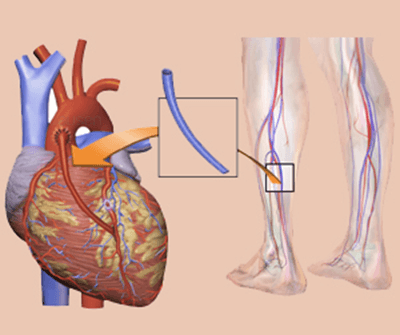What is the full form of CABGCABG: Coronary Artery Bypass GraftCABG stands for Coronary Artery Bypass Graft. It is a surgical procedure for treating severe coronary heart disease in which blood flow to the heart muscles is interrupted due to a blockage. So, it is mainly performed to improve the blood flow to the heart and thereby reduce the chances of a heart attack. CHD is caused when a waxy substance (plaque) builds up inside the coronary arteries, which supply oxygenated blood to the heart. Over time, the plaque may harden and narrow the arteries and thus can interrupt the flow of oxygenated blood to the heart. It usually results in chest pain called angina. 
In CABG, a new route is created around the blocked artery so that blood can be sent to the heart muscle through this route. In this procedure, a piece of vein from some other part of your body is used to bypass the blocked portion of the coronary artery. Usually, a healthy piece of vein from the leg or a piece of the artery in the chest or wrist is taken and then attached to the affected coronary artery just above and below the blocked area of the artery to bypass the blockage. Purpose of CABG
Common symptoms
Complications
Recovery
Surgical risksA coronary artery bypass transplant carries a risk of complications, much like any form of surgery. There is a chance of major problems, such as a stroke or heart attack, but they are mostly manageable and mild, like an irregular heartbeat or a wound infection. Risks of SurgeryMost patients will notice a significant improvement in their dyspnea and chest pain following a coronary artery bypass graft, and their chance of having a heart attack will be reduced. The treatment for coronary heart disease, however, is not a coronary artery bypass transplant. Your transplanted arteries will gradually harden and constrict if you do not adjust your lifestyle, such as eating a healthy diet and exercising frequently. Occasionally, you might require a second coronary artery bypass graft or a procedure to open your arteries using a tiny balloon and a tube known as a stent (coronary angioplasty). AlternativesThe primary alternative to a coronary artery bypass graft is coronary angioplasty. In this less invasive treatment, a catheter-a lengthy, flexible, hollow plastic tube-is inserted into a blood vessel in your arm or groyne. The catheter's tip is guided by an X-ray to the arteries supplying your heart, precisely where the arterial constriction has taken place. A short metal tube called a stent is frequently used to assist in maintaining the artery open after a balloon attached to the catheter is inflated to expand the artery. Compared to a coronary artery bypass graft, a coronary angioplasty normally requires lesser recovery time, but there is a higher chance that the procedure will need to be redone. Additionally, if several coronary arteries have constricted and/or become blocked, or if the structure of the blood vessels close to your heart is aberrant, a coronary angioplasty may not be advised.
Next TopicFull Form
|
 For Videos Join Our Youtube Channel: Join Now
For Videos Join Our Youtube Channel: Join Now
Feedback
- Send your Feedback to [email protected]
Help Others, Please Share










